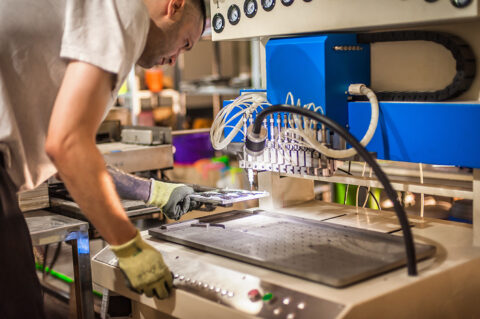This month offered a study in contrasts for U.S. manufacturing. On one side were bold, multi-billion-dollar investments from major players—decisions that signal long-term confidence in American industrial capacity. On the other, the demand picture remained uneven. The S&P Global U.S. Manufacturing PMI rose to 52.5, reflecting modest expansion, while the ISM Manufacturing PMI registered 48.7, signaling contraction. For manufacturers, navigating this gap between long-term momentum and short-term pressure remains the central challenge.
MAIN STORIES
1. Stellantis’ $13 Billion Bet Rewrites the Supplier Playbook
The Story:
Stellantis announced a sweeping $13 billion U.S. investment program, including reopening the Belvidere, Illinois assembly plant and adding roughly 5,000 jobs nationwide—3,300 of them tied directly to Belvidere. This marks one of the largest automotive manufacturing commitments in years.
Why It Matters:
This announcement isn’t simply an OEM expanding capacity—it reshapes the supplier network map across the Midwest. Tooling, automation, machining, stamping, sub-assemblies, quality systems, and logistics all come into play. For small manufacturers, this opens new lanes to qualification and long-term supply relationships.
The Bigger Picture:
Major OEM commitments such as this reinforce the broader 20- to 30-year reshoring trend. Large programs don’t succeed without robust supplier ecosystems, meaning opportunity spreads across hundreds of small and midsized manufacturers.
2. Amkor’s $7 Billion Packaging Campus Anchors a Critical Part of the Chip Supply Chain
The Story:
Amkor Technology broke ground on a new $7 billion advanced-packaging and test campus in Peoria, Arizona—one of the largest dedicated packaging investments in recent U.S. history. Initial production is planned to begin in 2028.
Why It Matters:
Advanced packaging has become a strategic bottleneck. Without it, wafer-fabrication investments cannot translate into usable downstream products. This single campus positions the U.S. to compete more effectively in commercial and defense technology markets.
The Bigger Picture:
This investment reinforces the shift toward distributed semiconductor capacity across multiple states. For toolmakers, automation providers, sub-assembly manufacturers, and material suppliers, Amkor’s build-out will generate sustained demand through design, construction, and ongoing operations.
3. PMI Divergence: S&P Shows Expansion, ISM Signals Contraction
The Story:
Two major barometers pointed in different directions in October:
- S&P Global U.S. Manufacturing PMI: 52.5 (expansion)
- ISM Manufacturing PMI: 48.7 (contraction)
Why It Matters:
This divergence underscores a sector straddling two realities: long-term strategic investment and short-term demand softness. S&P’s survey captures broader industrial activity, while ISM’s more manufacturing-specific read flagged contraction in new orders, production, employment, and exports.
The Bigger Picture:
Manufacturers must balance cautious hiring and inventory management with strategic preparation for the ongoing reshoring cycle. Knowing where to invest—and when—is increasingly dependent on aligning tactical decisions with long-term structural trends.
4. A Broad Month of Announcements Across Multiple Sectors
The Story:
Across pharmaceuticals, semiconductor packaging, battery technology, and consumer products, October saw new U.S. manufacturing operations announced nationwide. Industry activity was not concentrated in a single sector.
Why It Matters:
Cross-sector growth signals that the manufacturing resurgence is broad, not isolated. Multiple growth nodes create diversified opportunities for domestic suppliers.
The Bigger Picture:
A more balanced ecosystem supports resilience. As reshoring accelerates, suppliers can hedge cycles by engaging across automotive, advanced manufacturing, electronics, life sciences, and clean-tech sectors.
QUICK HITS
- Federal procurement thresholds changed on October 1, expanding small-business access to government purchasing pathways.
- Semiconductor project momentum continued nationwide, with cumulative fab, packaging, and test investments tracking upward.
- Supplier readiness took center stage as major OEM and semiconductor programs emphasized qualification and capability alignment.
- Exports continued lagging with soft order books, consistent with ISM’s export index readings.
- Inventories remained tight while supplier deliveries showed slowing, reinforcing ongoing supply-chain friction points.
FEATURE
The Long Tail of U.S. Manufacturing: Why Small Suppliers Should Lean In
Stellantis’ and Amkor’s announcements were big headlines, but the real story is what these programs mean for small and mid-sized suppliers. Major investments create thousands of downstream touchpoints: prototyping, tooling, machining, electronics, coatings, automation, inspection, and specialized materials.
For suppliers, October’s announcements are signals. The companies that prepare now—clean quality documentation, shore up capacity, strengthen relationships with regional partners—will be positioned to win early production slots and establish long-term commitments.
LOOKING AHEAD
November and December will be critical months to track:
- Supplier qualification cycles for Stellantis’ reopened facilities
- Construction and procurement triggers tied to the Amkor Arizona campus
- Federal FY26 contracting activity following threshold changes
- Backlog and order signals as PMI divergence continues
Bottom line: October reaffirmed a familiar pattern: strategic capital is flowing into U.S. manufacturing even as short-term demand remains mixed. The opportunity for manufacturers—especially small and midsized suppliers—is to invest in readiness now so they can benefit as these major projects accelerate.




